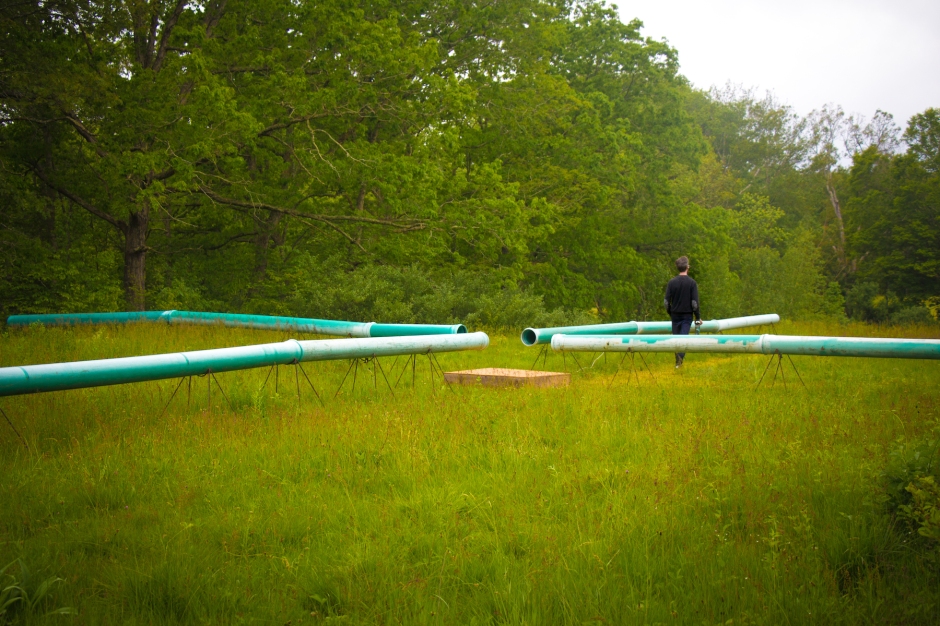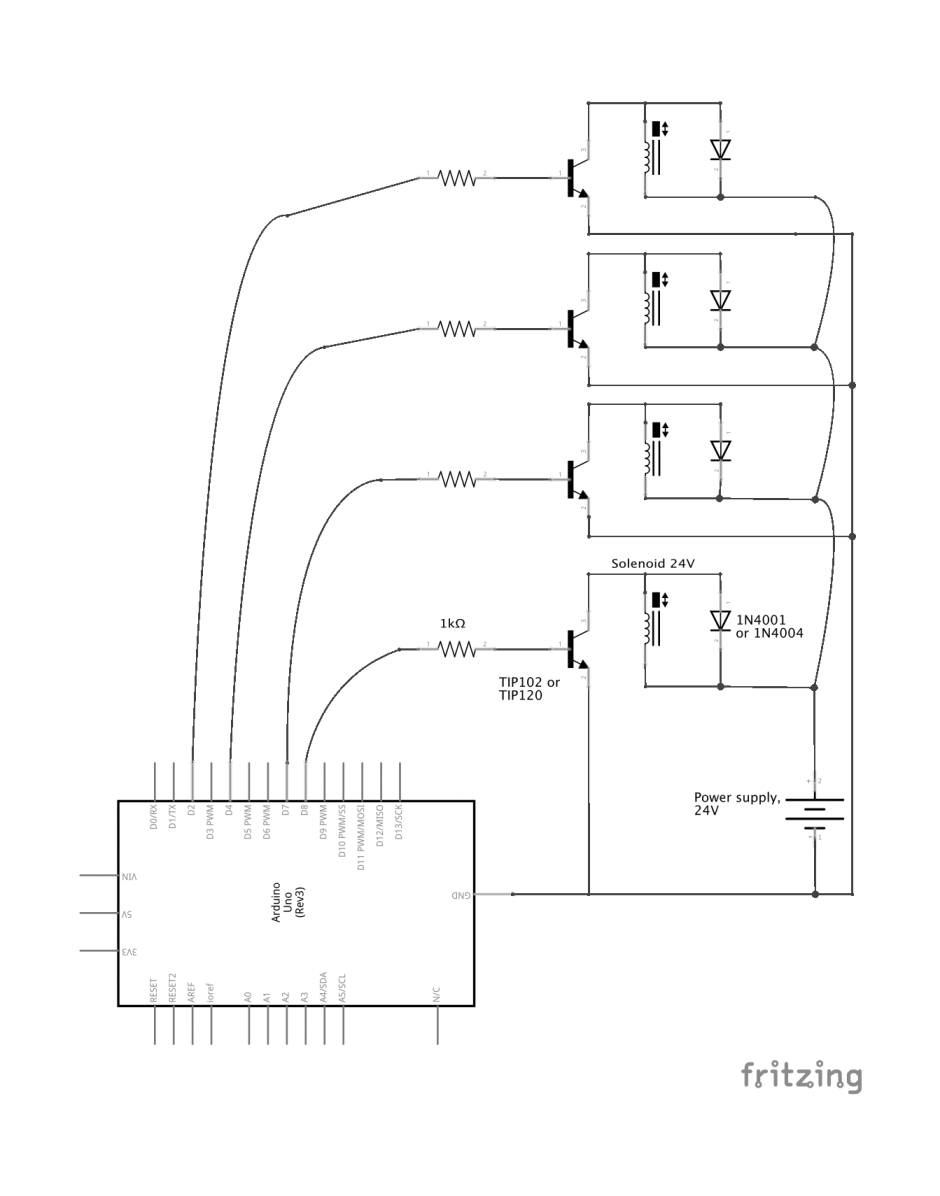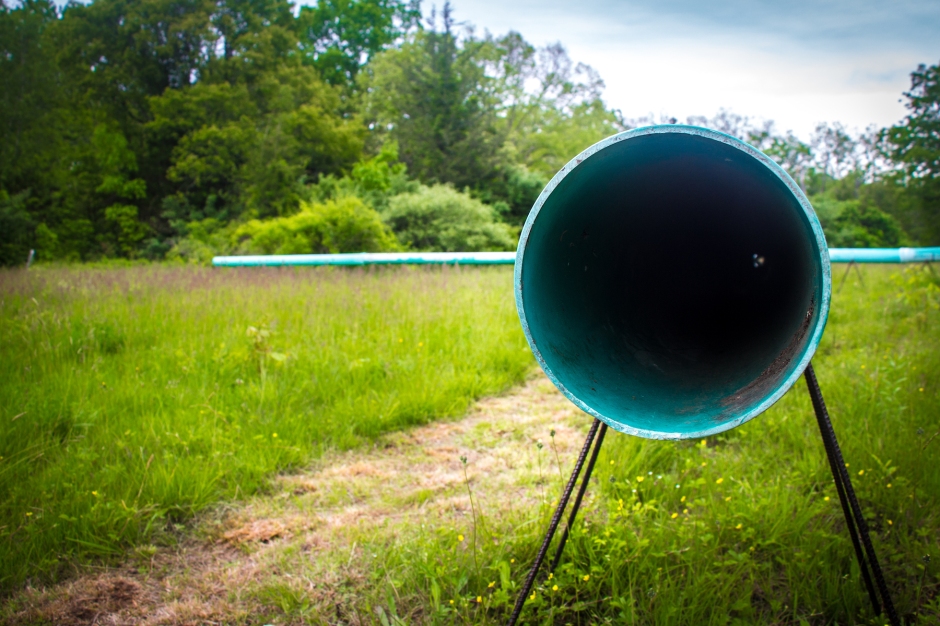The listener sits at the middle of four pipes, which are hit by motors producing percussive patterns.
Four recordings were taken with a microphone pointing at each one of the cardinal points, at different times of the day; the pipes’ length is tuned to the corresponding “keynote” of the soundscape. The rhythm is also derived from an analysis of the sound attacks in the recordings.
Made with Arduino Uno, 4x solenoids, 12x Pipes
Made at the I-Park residency for the Site-Responsive Art Biennale, I-Park Foundation, East Haddam CT (USA) – May/June 2017

THANKS TO: JULIE POITRAS SANTOS, ERICA VAN LOON, BRIDGET QUINN, HUGH LIVINGSTON, WHALEN POLIKOFF, RALPH CRISPINO, BILL&STEVE. Pictures by Christina Goldberg
The schematics hereunder, made with Fritzing, shows how the components are connected. I used 24V solenoids mostly because that’s what was available at the store. In this version you need to power the Arduino separately, but a smarter solution can be found.

This scheme is basically derived from this instructable. You will need:
- 1 Arduino Board (I used Arduino UNO)
- 4x resistors, 1 kΩ
- 4x diodes, 1n4001 or equivalent
- 4x transistors, TIP102 or equivalent
- 4x solenoids, in my case 24V
- 1 power supply 24V
- 1 power supply for Arduino
Find a tutorial about this on Hackster.io.
The code was generated (and then modified) by programming a custom software that would create MIDI files with one MIDI note each time a recording went above a certain volume threshold. Then the duration of these notes was adjusted to few ms by using a MIDI editor. The resulting MIDI file was sent through this MIDI-to-arduno processor, after having named the MIDI tracks as needed.
It doesn’t make sense to share the whole code (more than 11.000 lines), but the beginning looks like this:
void setup(){
pinMode(2, OUTPUT);
pinMode(4, OUTPUT);
pinMode(7, OUTPUT);
pinMode(8, OUTPUT);
doPerformance();
}
void loop(){
}
void doPerformance(){
delay(10);
digitalWrite(2,HIGH);
digitalWrite(4,HIGH);
digitalWrite(7,HIGH);
digitalWrite(8,HIGH);
delay(984);
digitalWrite(2,LOW);
digitalWrite(4,LOW);
digitalWrite(7,LOW);
digitalWrite(8,LOW);
delay(299);
digitalWrite(2,HIGH);
delay(740);
digitalWrite(2,LOW);
delay(485);
digitalWrite(8,HIGH);
delay(551);
digitalWrite(8,LOW);
delay(165);
digitalWrite(8,HIGH);
delay(354);
digitalWrite(8,LOW);
delay(1);
digitalWrite(8,HIGH);
delay(344);
digitalWrite(4,HIGH);
delay(103);
digitalWrite(8,LOW);
delay(24);
digitalWrite(4,LOW);
delay(283);
digitalWrite(8,HIGH);
delay(747);
digitalWrite(8,LOW);
delay(318);
digitalWrite(8,HIGH);
delay(683);
digitalWrite(8,LOW);
delay(1);
digitalWrite(8,HIGH);
delay(58);
digitalWrite(8,LOW);
delay(493);
digitalWrite(4,HIGH);
delay(32);
digitalWrite(8,HIGH);
}
This can be basically used for any set with four solenoids, and can be scaled up or down as needed. For this very installation, the solenoids were hitting four different sets of three sewer pipes each.


“The sound compass” by Alessandro Perini is distributed under a Creative Commons License – Attribution – Non-commercial – Share Alike 4.0 International.
For further permissions: https://alessandroperini.com/contact/.

Pingback: Alessandro Perini’s The Sound Compass #MusicMonday « Adafruit Industries – Makers, hackers, artists, designers and engineers!
Pingback: Alessandro Perini’s The Sound Compass #MusicMonday – Open Electronics Project
Pingback: Intorno alla traccia | Alessandro Perini